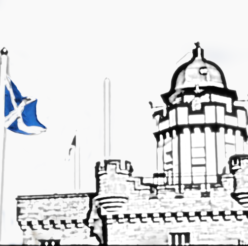Angus Bancroft
In pandemic times social time seems to give way to virus time. The time the infection takes to replicate, transmit and reinfect is now the basic unit of time which supersedes other rhythms of social and economic life. There is a much longer historical virus time. To be human is to carry the imprint of virus responses in our immune systems and DNA. Viruses have their own biological historical record. Edinburgh is scattered with monuments to the medical history of the place. There are statues to medical pioneers, far too many plaques to read and grasp, each marking the struggle between humanity and mortality. On Princes Street sits a statue to James Young Simpson, one of the pioneers who developed chloroform as an anaesthetic. Another imprint of disease and public medicine is less pronounced but more chatty, the folds in the land . There are the plague mounds, cemeteries, and the plague barriers, remnants of barriers between folk designed to ensure social and contagion distance, and the draughty working class housing that was an attempt to get a grip on miasma and contagion.
The collision between theories of humanity and theories of disease contagion is worth attention. It is written stone and earth. In creates new ways of governing humans, tagging and sorting them and shifting some to the edge of the expanding city, to new sites like Niddrie. Improvement moral, economic, social and sanitary reshaped the city and resorted its inhabitants. Planners theorised how bodies would mix. The vertical social segregation of the Old Town gave way to the horizontal separation of the new suburbs. Internal and external architecture was informed by ideas about hygiene and sanitation alongside privacy, ownership, divisions of domestic labour and time.
The evidence of past social innovations and public health crises is visible in the physical form of the city and also its social dynamics and the cultural and imaginary distance between places. The current pandemic will produce its own legacy in the physical and organisational infrastructure while as a society we move onto the next worry. Looking at past pandemics is going to be crucial to understanding the challenges involved.
